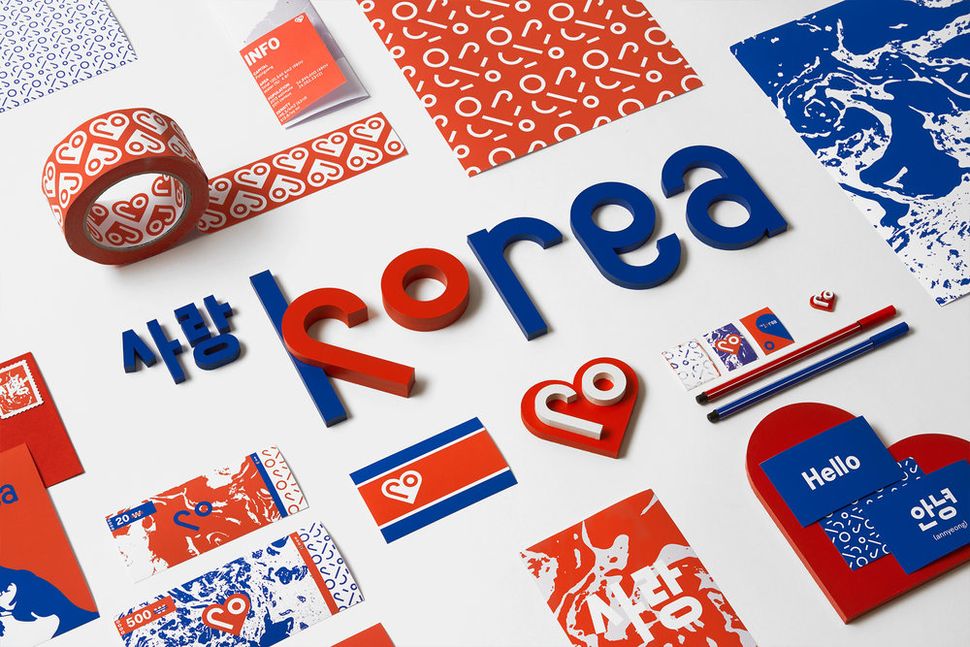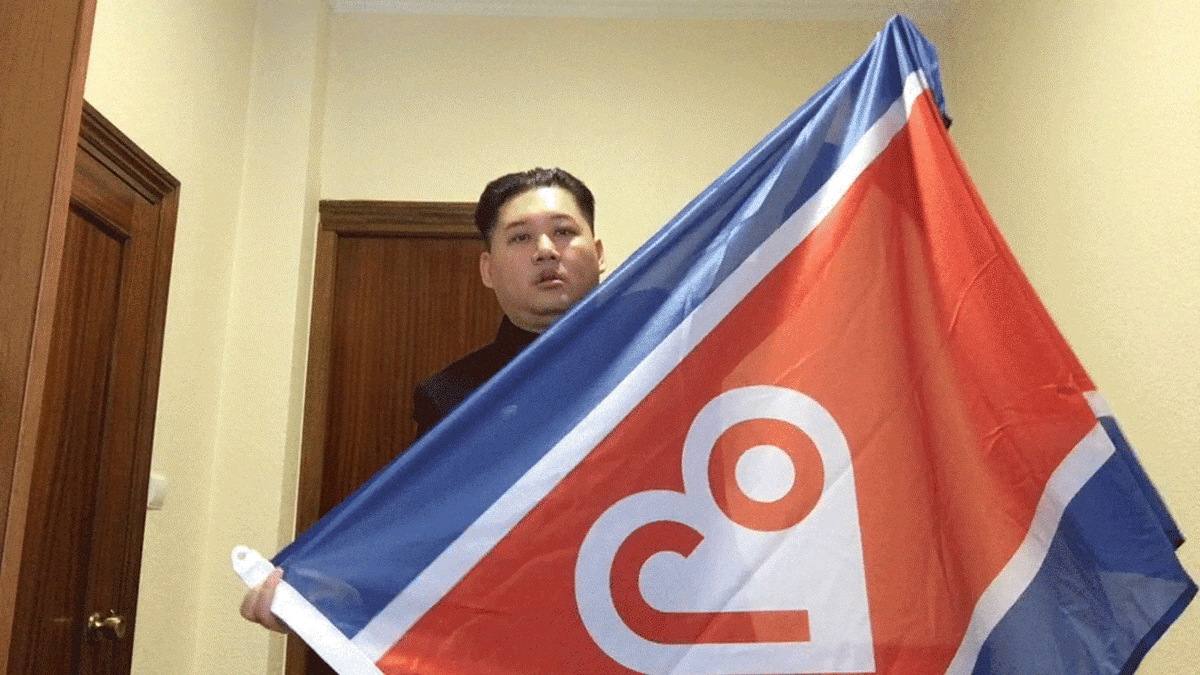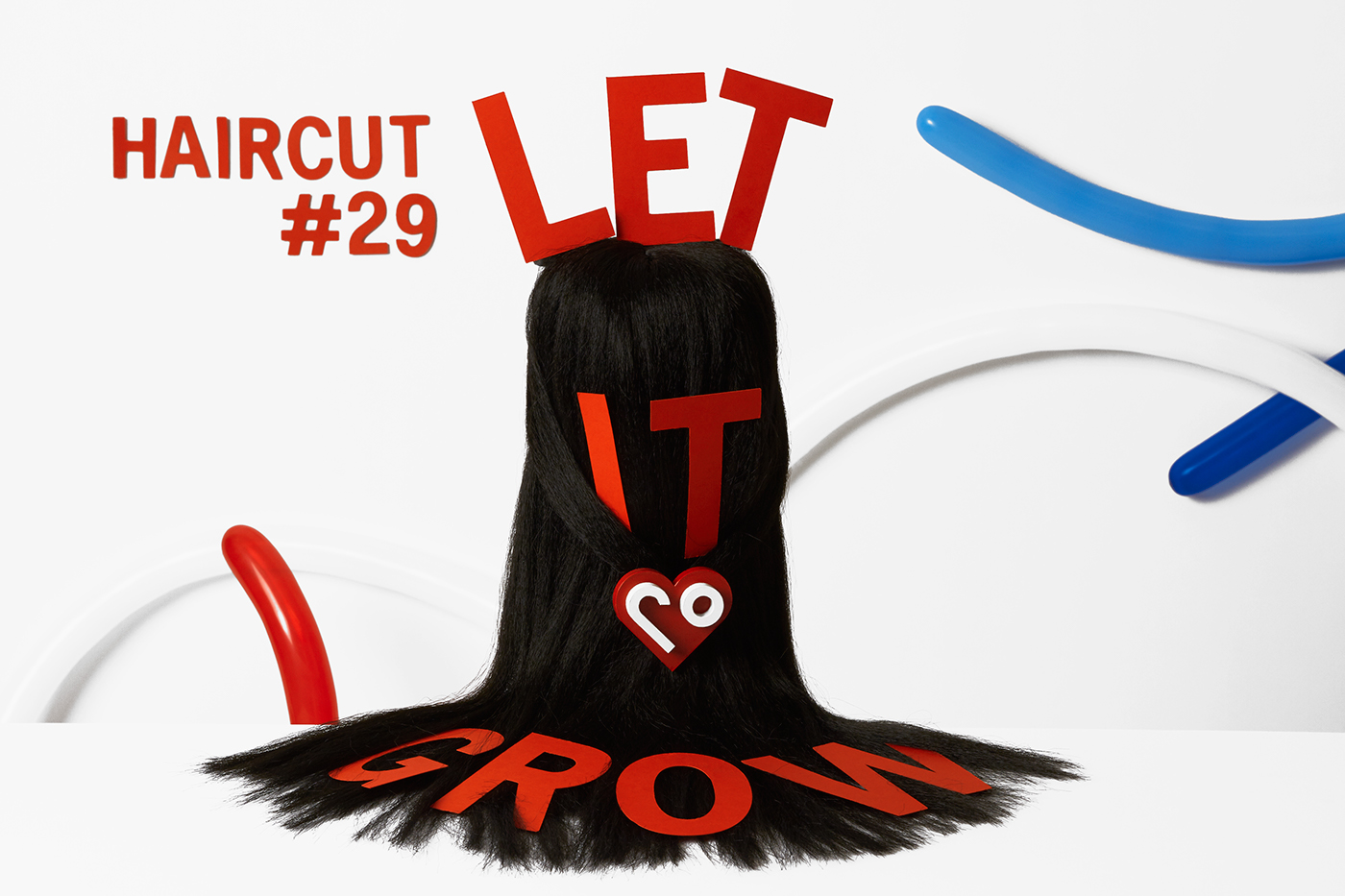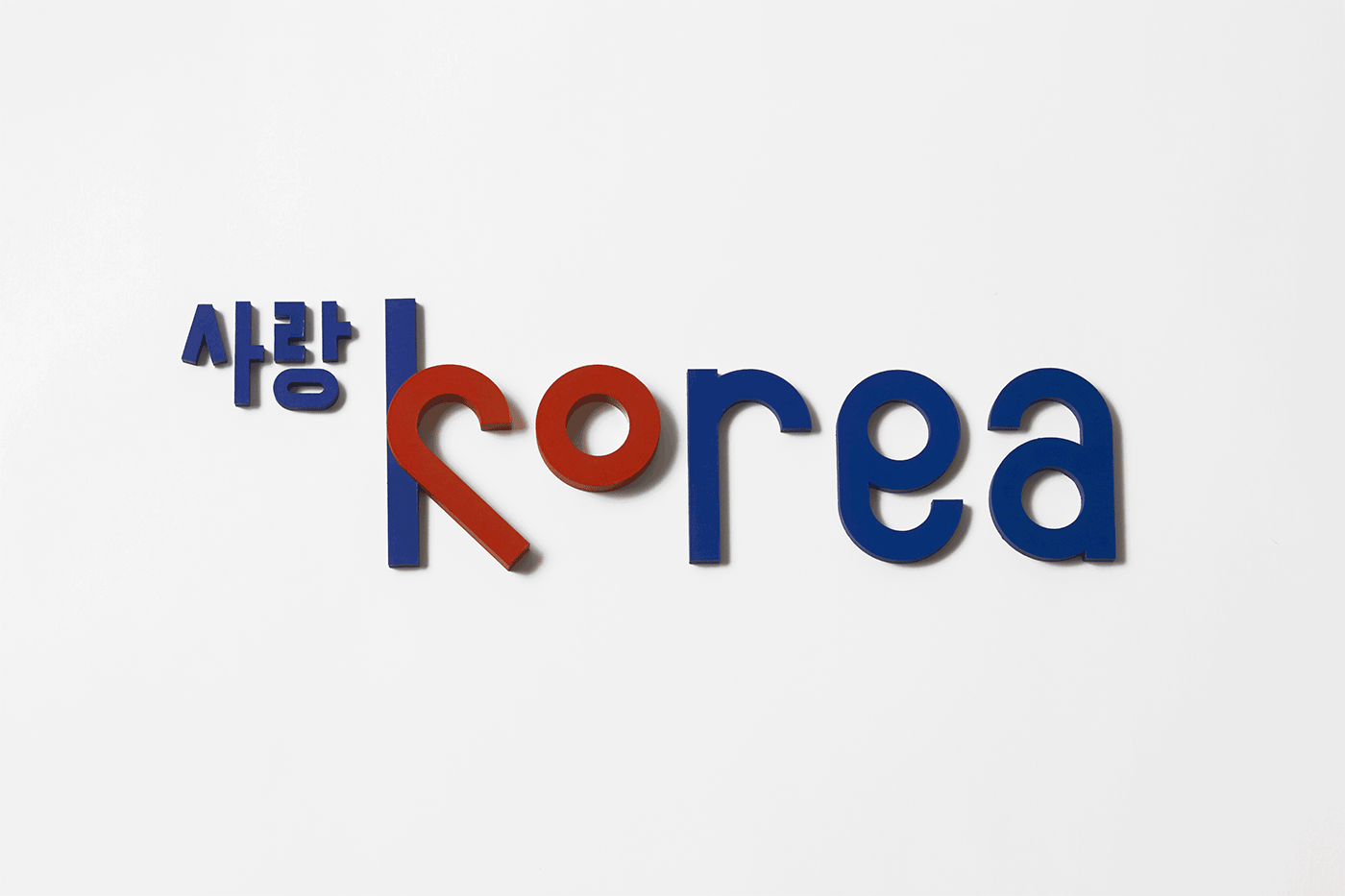- this is an interesting approach to a new Korea, and we can take a lot from the project in terms of inspiration and the guidelines and considerations they had to put into place to appropriately approach it. I'm particularly attracted to the 3-dimensional feel to the type and the combination of the two languages letterforms/glyphs; applying this to the same colour scheme but bringing them into the present with the rest of the world.
 Not one to shy away from controversial or edgy projects, creative agency Snask is back with a rebrand of North Korea that explores how the country might look if it softened up a bit. The result is Love Korea, a humourous website which showcases the various ways North Korea could compromise some of its stricter policies, including radical haircut ideas, a new flag, and redesigned currency.
Not one to shy away from controversial or edgy projects, creative agency Snask is back with a rebrand of North Korea that explores how the country might look if it softened up a bit. The result is Love Korea, a humourous website which showcases the various ways North Korea could compromise some of its stricter policies, including radical haircut ideas, a new flag, and redesigned currency.For the founder and creative director of Snask, Fredrik Öst, this was a dream project that has long been on his to-do list. "We've always wanted to rebrand North Korea because it's such a challenge," he explains. "To brand a country alone would be a dream, but doing North Korea means incredible challenges and opportunities.
"They have extremely bad awareness of their own brand and how it's perceived by the rest of the world," he adds. "On top of that they have a completely wrong view of themselves, believing their country is the best and their leader is a role model for the rest of the world within leadership, running a country, fashion, sports, dictatorship I guess, and many more. Also turning something bad into something good is a dream for us and something we always wanted to do."
"We based the whole rebrand on a new and changed North Korea where it's become a free democracy by international standards," Öst reveals. "But we didn't want to ridicule them, rather show an alternative route where some parts were left and others changed."

The collateral was all sent to Kim and they a received a video back!
The name Love Korea lead to the communist star on the flag being replaced by a heart, which in turn become the symbol of the country. As for keeping the flag's colours the same, this was an intentional move as the colour scheme is the same as South Korea and helps to tie the two countries together.
"We also chose to add a new hairstyle which would liberate the citizens and allow them to grow their hair to any length and style. They only have 28 allowed hairstyles today," says Öst.

Despite this caution, Öst reasons that the average Korean will probably never see their hard work. "They only have seven websites in their domain," he says "But if they see it I hope they like the idea of it. When it comes to Kim Jong-Un, I really hope it somehow sparks an idea that being loved and open arms are much nicer than the opposite."
"We also chose to add a new hairstyle which would liberate the citizens and allow them to grow their hair to any length and style. They only have 28 allowed hairstyles today," says Öst.

Considering that dealing with North Korea is an incredibly delicate matter even at the best of times, Snask were careful not to mock the country and its citizens. "It was a rule we put from the very beginning," says Öst "We didn't want to stomp in and tell them that everything is shit, even though a lot of their ways of treating their citizens are in line with a dictatorship. But we didn't want to mock them or ridicule their country. We wanted to simply inspire and show a real possible new way."
Response from Photography studio - the response we received off the visiting photographers about Korea did provide some very useful insights to their visit and the questions we had regarding the main conspiracies commonly associated with the country:
"Hi Anna,
Great questions! There is a huge amount I could say in answer to most of them - it was easily the most interesting place I've been to photograph - so I've tried to answer each one concisely in the below, but if you want more detail beyond simple clarifications then a phonecall may well be the easiest way to flesh out anything you still need.
1. What was your motivation/goal in documenting your journey to North Korea?
Our main motivation behind the exhibit was to show a side of North Korea that we felt was unfairly unrepresented in popular culture - specifically the side that was people going about their everyday lives! So much of the media/popular perception is about the "crazy backwardness" of the country and unsubstantiated myths - it's such an easy place to dismiss because knowledge is low. And obviously there are some serious political and humanitarian issues that should be addressed, no-one is disputing that - but it struck us as unreasonably superior/close-minded for the normal Western position to be point-and-sneer, and we wanted to show photos that would challenge the common belief that 25m people aren't worth engaging with.
2. Was there anything that surprised you about being there? Where there any perception you had about the country that was debunked or proved?
As you can see from my first answer, for sure! We were surprised by how much the people we interacted with wanted us to have a great time and learn their point of view. Our guides/minders who were always with the group were fantastic tour guides and very happy to discuss a wide range of cultural questions. We were amazed at how much we were shown and how much we travelled.
3. From research we've done we've noticed there is an obvious difference in the perception you have shown with your work, in comparison to the image painted by our media in terms of secrecy and conspiracies. Any insight into this?
And deliberately so. I'll reiterate as it's so important to us - we know there are horrible things happening in the country, from unsanctioned nuclear development to suppression of the population and widespread famine. But we felt we couldn't come back and play out that trope because (a) everyone knows this. It's been widely reported by people much more knowledgeable in the local history than us (b) we didn't see it! It would be like going for a shopping weekend in New York and then coming back to tell everyone how terrible the murder rate is in Detroit. True but irrelevant - and we have no new insight to bring to that. So instead we chose to show some of the people that we met, some of the beautiful things we saw, to help attendees of the exhibit see past the simplistic (and unnecessarily superior) viewpoint of most popular writings/photos and reflect a little on how we can become so comfortable writing off 25m people as alien and "evil"
4. How did you personally find the atmosphere like in North Korea? eg Tense, uneasy, intriguing?
All of the above at different times! Knowing you're always being observed, and possibly being listened to even in your own hotel room, is a strange experience. I think we take for granted the ability to openly reflect on a day with friends over dinner - which just wasn't possible over there - and when the days are so interesting/challenging this difficulty is compounded! And going through customs is the tensest pleasant experience I think I've ever been through!
5. Were you restricted in what you could take photos of? Did this inform your work?
Yes, but less than we'd thought. Basic rules: no soldiers, no military buildings, no close-ups of people (because it's rude...fair enough!), no construction (they perceived work-in-progress as shameful somehow - as though it was a sign of weakness rather than development), DEFINITELY nothing at military checkpoints, nothing of the Kims that didn't have them in full view and "with respect" i.e. no silly faces in front of a statue. So yes this did inform the work - but this then helped us construct a different image of the country versus what people normally have in their head. And actually those rules only applied for <5% of the whole trip - and often they weren't fully enforced. For example I have several pictures of soldiers in the DMZ (e.g. "Watching" https://www.koryocollective.co.uk /buy-prints/watching) because as a group we'd won the trust of our guide and the soldier involved.
6. When you were walking around the streets with your photographic gear did you feel welcomed or like you were being intrusive or being intently watched?
Our tour guides wanted us to take photos - they knew that it's an integral part of being a tourist! So often if we weren't allowed to take a photo at that point, maybe because there was a soldier in the frame, our guide would say "we'll take you somewhere later with a similar view but without soldiers" Soldiers would generally check out the equipment - but I've been places in Beirut and US that were more hostile to photographers! Occasionally members of the group did have their photos checked/deleted - but again this isn't the only place in the world this has happened to me and it was never done with aggression, as it was assumed no-one was deliberately trying to take the piss
7. Did you notice any typography or unique signs that caught your eye while you were walking around the streets?
The propaganda was unavoidable - and slogans of dramatic white lettering on red background (I've attached a simple example from google). Slogans written in this form were to be shown respect - you couldn't lean against them or take silly photos of them or anything. Most interesting for me was the fact that we never saw an advertisement... They still had posters at the bus stops but rather than selling insurance or cider, they just had huge photos of pretty things e.g. a sunset view over Pyongyang or a picture of children running through a park. Actually quite pleasant!
8. Did you visit any artistic spaces? Were any available to see? If so what kind of work was there?
Not really - we went to some places that produced crafts for tourists to buy, but it was more replication of core images rather than genuine creation of new art. The craftspeople were clearly respected though - it was no mass production factory and the skill was impressive.
9. Did you get the chance to talk any of the citizens living there? Did you hear any stories from them at all?
We spent the most (i.e. all!) time with our two minders - one man, one woman - and they were happy to tell stories. One night we'd been to a pretty boozy dinner and on the bus back to the hotel they took turns to sing a traditional Korean folk song - it's called Arirang, you can find it on the internet - it's main subject is unrequited love. The lady sang it exquisitely, really mournful and beautiful - but
when the (younger) man came to it, he made it much more upbeat and pacy. It made her smiling shake her head and make some comment about how the youth have no respect for traditions - she was half-joking but a wonderful moment that I can imagine everyone in the world would be able to identify with!"



No comments:
Post a Comment